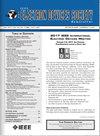掺硅氧化铪基铁电场效应晶体管的峰值时序依赖学习动力学
IF 2.4
3区 工程技术
Q3 ENGINEERING, ELECTRICAL & ELECTRONIC
引用次数: 0
摘要
以大脑为灵感的计算,由于其在高能效时空数据处理方面的潜力,激发了人们对脉冲神经网络及其硬件实现的极大兴趣。利用其非易失性存储器和模拟可调性,铁电场效应晶体管已成为在尖峰神经网络中实现低功耗突触器件的有希望的候选者。然而,以往基于铁电场效应晶体管实现的峰值时间相关可塑性(峰值神经网络的重要学习机制)往往依赖于复杂的电路拓扑结构或高能耗。在这里,我们报告了一项全面的研究,研究了硅掺杂氧化铪基铁电场效应晶体管中脉冲时间依赖的可塑性学习动力学,展示了使用各种脉冲形状和时间精确控制突触权重调制。我们研究了不同尖峰波形对能量消耗的影响,发现与矩形尖峰相比,三角形尖峰的能量消耗减少了20%,这对于大规模尖峰神经网络的实现来说是一个显著的改进。我们的研究结果强调了单器件铁电场效应晶体管突触在实现节能和可扩展的尖峰神经网络方面的潜力,为下一代神经形态计算铺平了道路。本文章由计算机程序翻译,如有差异,请以英文原文为准。
Spike-Timing Dependent Learning Dynamics in Silicon-Doped Hafnium-Oxide-Based Ferroelectric Field Effect Transistors
Brain-inspired computing, with its potential for energy-efficient spatio-temporal data processing, has spurred significant interest in spiking neural networks and their hardware implementations. Leveraging their non-volatile memory and analog tunability, Ferroelectric field-effect transistors have emerged as promising candidates for realizing low-power synaptic devices within spiking neural networks. However, previous ferroelectric field-effect transistor-based implementations of spike-timing-dependent plasticity, a crucial learning mechanism in spiking neural networks, have often relied on complex circuit topologies or suffered from high energy consumption. Here, we report a comprehensive study of spike-timing-dependent plasticity learning dynamics in silicon-doped hafnium oxide-based ferroelectric field effect transistors, demonstrating precise control of synaptic weight modulation using various spike shapes and timings. We investigate the impact of different spike waveforms on energy consumption and find that triangular spikes achieve a 20% reduction in energy consumption compared to rectangular spikes, a significant improvement for large-scale spiking neural network implementations. Our results highlight the potential of single-device ferroelectric field-effect transistor synapses for realizing energy-efficient and scalable spiking neural networks, paving the way for next-generation neuromorphic computing.
求助全文
通过发布文献求助,成功后即可免费获取论文全文。
去求助
来源期刊

IEEE Journal of the Electron Devices Society
Biochemistry, Genetics and Molecular Biology-Biotechnology
CiteScore
5.20
自引率
4.30%
发文量
124
审稿时长
9 weeks
期刊介绍:
The IEEE Journal of the Electron Devices Society (J-EDS) is an open-access, fully electronic scientific journal publishing papers ranging from fundamental to applied research that are scientifically rigorous and relevant to electron devices. The J-EDS publishes original and significant contributions relating to the theory, modelling, design, performance, and reliability of electron and ion integrated circuit devices and interconnects, involving insulators, metals, organic materials, micro-plasmas, semiconductors, quantum-effect structures, vacuum devices, and emerging materials with applications in bioelectronics, biomedical electronics, computation, communications, displays, microelectromechanics, imaging, micro-actuators, nanodevices, optoelectronics, photovoltaics, power IC''s, and micro-sensors. Tutorial and review papers on these subjects are, also, published. And, occasionally special issues with a collection of papers on particular areas in more depth and breadth are, also, published. J-EDS publishes all papers that are judged to be technically valid and original.
 求助内容:
求助内容: 应助结果提醒方式:
应助结果提醒方式:


